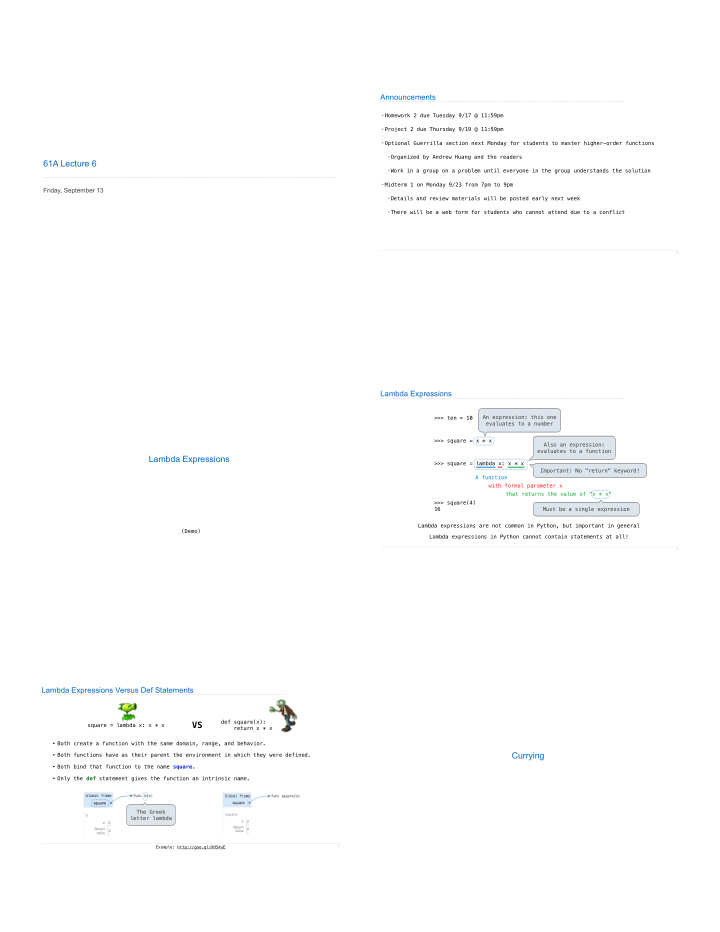



Announcements • Homework 2 due Tuesday 9/17 @ 11:59pm • Project 2 due Thursday 9/19 @ 11:59pm • Optional Guerrilla section next Monday for students to master higher-order functions Organized by Andrew Huang and the readers 61A Lecture 6 Work in a group on a problem until everyone in the group understands the solution • Midterm 1 on Monday 9/23 from 7pm to 9pm Friday, September 13 Details and review materials will be posted early next week There will be a web form for students who cannot attend due to a conflict 2 Lambda Expressions An expression: this one >>> ten = 10 evaluates to a number >>> square = x * x Also an expression: evaluates to a function Lambda Expressions >>> square = lambda x: x * x Important : No "return" keyword! A function with formal parameter x that returns the value of "x * x" >>> square(4) 16 Must be a single expression Lambda expressions are not common in Python, but important in general (Demo) Lambda expressions in Python cannot contain statements at all! 4 Lambda Expressions Versus Def Statements def square(x): VS square = lambda x: x * x return x * x • Both create a function with the same domain, range, and behavior. Currying • Both functions have as their parent the environment in which they were defined. • Both bind that function to the name square . • Only the def statement gives the function an intrinsic name. The Greek letter lambda 5 Example: http://goo.gl/XH54uE
Function Currying def make_adder(n): return lambda k: n + k >>> make_adder(2)(3) There's a general 5 relationship between (Demo) >>> add(2, 3) Newton's Method these functions 5 Currying: Transforming a multi-argument function into a single-argument, higher-order function. Currying was discovered by Moses Schönfinkel and re-discovered by Haskell Curry. Schönfinkeling? 7 Newton's Method Background Newton's Method Zero of Quickly finds accurate approximations to zeroes of differentiable functions! Given a function f and initial guess x, tangent line: Repeatedly improve x: � − ��� ) 2.5 Change to x: ����� -f(x)/f'(x) 1. Compute the value of f A "zero" of a function f is at the guess: f(x) f(x) = x 2 - 2 an input x such that f(x)=0 2. Compute the derivative -5 -2.5 0 2.5 5 of f at the guess: f'(x) Length from 0: -f(x) 3. Update guess x to be: Slope of this x=1.414213562373095 tangent line � − ��� ) is f'(x) -2.5 ����� Current point: (x, f(x)) Application: a method for computing square roots, cube roots, etc. Finish when f(x) = 0 (or close enough) The positive zero of f(x) = x 2 - a is . (We're solving the equation x 2 = a.) √ � 9 10 http://en.wikipedia.org/wiki/File:NewtonIteration_Ani.gif Using Newton's Method How to find the square root of 2? >>> f = lambda x: x*x - 2 f(x) = x 2 - 2 >>> df = lambda x: 2*x f'(x) = 2x >>> find_zero(f, df) Iterative Improvement 1.4142135623730951 Applies Newton's method until |f(x)| < 10 -15 , starting at 1 How to find the cube root of 729? >>> g = lambda x: x*x*x - 729 g(x) = x 3 - 729 >>> dg = lambda x: 3*x*x g'(x) = 3x 2 >>> find_zero(g, dg) V √ 3 V 9.0 11
Special Case: Square Roots Special Case: Cube Roots How to compute square_root(a) How to compute cube_root(a) Idea: Iteratively refine a guess x about the square root of a Idea: Iteratively refine a guess x about the cube root of a � = � + � � = � · � + � � � � Update: Update: � � Babylonian Method Implementation questions: Implementation questions: What guess should start the computation? What guess should start the computation? How do we know when we are finished? How do we know when we are finished? 13 14 Implementing Newton's Method (Demo)
Recommend
More recommend